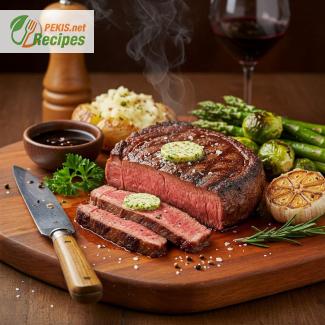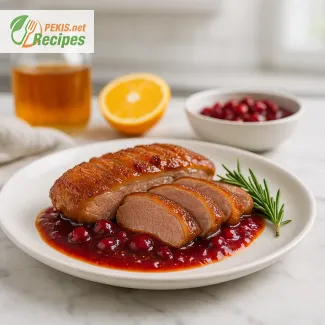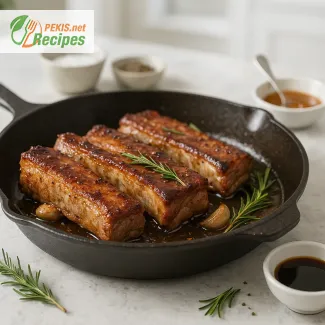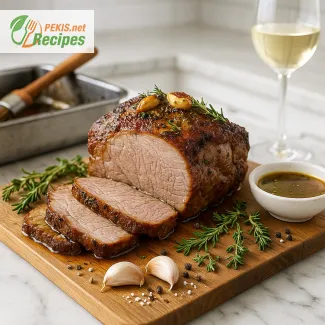
Mastering the Art of Delmonico Steak: A Timeless Culinary Delight
The Legacy of Delmonico Steak
The Delmonico steak is more than just a cut of beef—it’s a piece of culinary history. Originating from the legendary Delmonico’s Restaurant in New York City in the 19th century, this steak has earned a reputation for its tender texture, rich marbling, and unmatched flavor. Though the exact cut has been debated over time, what remains constant is the luxurious, buttery taste and the perfect sear that locks in the juices. If you’re looking to recreate a restaurant-quality steak at home, understanding the tradition, preparation, and key techniques is essential.
Selecting the Right Cut
Unlike other steaks that have a clear-cut definition, the Delmonico steak can vary depending on the butcher or region. Traditionally, it comes from the ribeye or short loin section, known for its intense marbling and deep beefy taste. Some chefs also prepare it using a top loin (New York strip) or boneless ribeye, both of which offer a rich, juicy bite with a satisfying charred crust. Regardless of the cut, a thick-cut, well-marbled steak is the hallmark of a proper Delmonico.
The Secret to Perfect Searing
One of the defining characteristics of a Delmonico steak is its perfect sear, which creates a golden-brown crust while keeping the inside tender and juicy. Achieving this requires high heat, proper seasoning, and a well-preheated cast-iron skillet. By using a combination of butter, garlic, and fresh herbs, you can infuse the meat with deep, savory flavors that enhance its natural richness.
For the best results:
- Let the steak rest at room temperature before cooking to ensure even heat distribution.
- Use a high-smoke point oil, such as avocado or grapeseed oil, to achieve a crispy exterior without burning.
- Finish with butter basting, allowing the fat to enhance the texture and add a silky, mouthwatering finish.
Cooking to the Perfect Temperature
Achieving the ideal doneness is key to enjoying the full potential of a Delmonico steak. Overcooking can result in toughness, while undercooking may not allow the marbling to fully render. A meat thermometer is the best tool for precision cooking:
- Rare: 50-52°C (120-125°F) – Cool, red center
- Medium-rare: 55-57°C (130-135°F) – Warm, red center (best for marbled cuts)
- Medium: 60-63°C (140-145°F) – Pink center with a firmer bite
- Medium-well: 65-68°C (150-155°F) – Slight pink but mostly browned interior
- Well-done: 70°C+ (160°F+) – Fully cooked through, but less juicy
For an authentic Delmonico experience, medium-rare to medium is the preferred choice, as it maximizes the tenderness and flavor.
The Final Touch: Resting and Serving
After cooking, resting the steak is just as important as the searing process. This step allows the juices to redistribute, ensuring each bite is succulent and flavorful. A 5-10 minute rest under a loose tent of foil will make all the difference.
To serve, consider pairing the Delmonico steak with classic steakhouse sides, such as:
- Garlic mashed potatoes – A creamy contrast to the bold flavors of the steak.
- Grilled asparagus or roasted Brussels sprouts – Adding a touch of earthiness and crunch.
- Red wine reduction sauce or compound butter – Enhancing the natural umami of the beef.
A Steak Worth Savoring
The Delmonico steak is more than just a meal; it’s a celebration of fine dining and expert cooking techniques. Whether you’re a seasoned home cook or trying this cut for the first time, mastering the perfect Delmonico steak is a culinary achievement. With the right cut, proper seasoning, and expert searing, you can bring the rich flavors of a legendary New York steakhouse right into your own kitchen.
Now that you know the art of choosing, cooking, and serving this iconic steak, it's time to put your skills to the test. Get ready to experience a steak that’s juicy, flavorful, and undeniably luxurious—just as it was meant to be.
- Prepare the steak: Remove the steak from the refrigerator 30 minutes before cooking to bring it to room temperature. Pat it dry with paper towels.
- Season the steak: Generously season both sides with salt and black pepper, ensuring even coverage.
- Preheat the pan: Heat a cast-iron skillet or heavy-bottomed pan over high heat for about 5 minutes until very hot. Add olive oil and let it shimmer.
- Sear the steak: Place the steak in the pan and sear for 3-4 minutes without moving it, allowing a deep brown crust to form. Flip and sear the other side for another 3-4 minutes.
- Butter baste: Reduce heat to medium-low, add butter, garlic, rosemary, and thyme to the pan. Tilt the pan slightly and use a spoon to continuously baste the steak with the melted butter for 1-2 minutes.
- Check for doneness: Use a meat thermometer to ensure the internal temperature reaches:
- Rare: 50-52°C (120-125°F)
- Medium-rare: 55-57°C (130-135°F) (recommended)
- Medium: 60-63°C (140-145°F)
- Rest the steak: Transfer the steak to a plate or cutting board, tent it loosely with foil, and let it rest for 5-10 minutes to retain juices.
- Slice and serve: Slice against the grain and serve with your favorite sides like garlic mashed potatoes, grilled asparagus, or a rich red wine reduction sauce.
Elevating Your Delmonico Steak: Expert Tips for a More Flavorful Experience
Choosing the Best Cut for Maximum Flavor
One of the most crucial elements of a perfect Delmonico steak is selecting the right cut of beef. While ribeye and boneless striploin are the most traditional choices, there are other premium cuts that can enhance the experience.
- Dry-aged beef: Opting for a dry-aged ribeye intensifies the umami flavor, creating a steak with deeper, more concentrated beef notes.
- Grass-fed vs. grain-fed beef: Grass-fed steak is leaner and has a more robust, earthy flavor, while grain-fed beef is known for its rich marbling and buttery texture.
- Wagyu or Angus beef: These high-quality beef varieties offer exceptional marbling, resulting in an even more succulent and flavorful steak.
The Importance of Seasoning and Marinades
A classic Delmonico steak is seasoned simply with salt and black pepper, but a well-balanced marinade or dry rub can elevate its taste even further.
- Dry rub for enhanced crust: A mix of smoked paprika, garlic powder, and a pinch of cayenne pepper adds a smoky and slightly spicy note while reinforcing the steak’s natural flavors.
- Herb-infused marinade: A blend of olive oil, crushed garlic, rosemary, thyme, and balsamic vinegar infuses the steak with depth and aroma, making it even more aromatic.
- Salt brining: Dry brining the steak for at least 45 minutes before cooking allows the salt to penetrate the muscle fibers, creating a more tender and evenly seasoned bite.
Enhancing the Searing Technique
A proper sear is the key to a flavorful Delmonico steak. Without the right technique, you risk overcooking the steak or failing to develop the essential crust.
- Using a cast-iron skillet: This type of pan retains heat evenly, ensuring a consistent sear and a deep Maillard reaction, which produces the steak’s iconic crust.
- Preheating the pan thoroughly: The skillet should be smoking hot before the steak touches the surface. A properly heated pan locks in the juices and prevents sticking.
- Cooking with clarified butter or ghee: Unlike regular butter, ghee has a higher smoke point, allowing for intense searing without burning.
Why Homemade Delmonico Steak is Better than Restaurant Versions
Cooking Delmonico steak at home provides better control over ingredients, cooking methods, and quality.
- Better beef selection: At home, you can choose high-quality, grass-fed, or aged beef, whereas restaurants may opt for less premium cuts to reduce costs.
- Custom seasoning & preparation: Many steakhouse seasonings contain excess sodium and preservatives, but when preparing at home, you can use fresh herbs and natural flavors.
- Perfect doneness control: Cooking at home ensures that the steak is prepared exactly to your preferred level, whereas restaurants may slightly overcook or undercook your order.
- Cost efficiency: A premium steakhouse meal can be expensive, whereas home-cooked steak delivers the same high-end experience at a fraction of the price.
Common Mistakes to Avoid When Cooking Delmonico Steak
Even experienced cooks can make critical errors when preparing steak. Avoiding these mistakes ensures a perfectly cooked Delmonico every time.
- Cooking steak straight from the fridge: This leads to uneven cooking. Let the steak rest at room temperature for at least 30 minutes before cooking.
- Using cold butter for basting: Butter should be melted and infused with garlic and herbs before basting, ensuring the flavors fully penetrate the meat.
- Over-flipping the steak: Frequent flipping prevents a good crust from forming. Flip the steak only once for an even sear.
- Skipping the resting period: Resting the steak for 5-10 minutes after cooking ensures that the juices redistribute, preventing a dry steak.
Healthier Alternatives to Classic Delmonico Steak
While Delmonico steak is naturally rich in protein and healthy fats, it can be modified for a healthier version without compromising taste.
- Lean beef selection: Choosing grass-fed beef over grain-fed beef results in a higher omega-3 content and lower saturated fat.
- Butter alternatives: Instead of traditional butter, try avocado oil or extra virgin olive oil for a healthier fat profile.
- Lower sodium seasoning: Replace excess salt with herbs, garlic, and citrus zest for a flavor boost without added sodium.
- Vegetable sides over heavy starches: Instead of mashed potatoes, opt for grilled asparagus, roasted Brussels sprouts, or sautéed mushrooms to add fiber and nutrients.
Perfect Pairings to Elevate the Dish
A Delmonico steak is incomplete without the right accompaniments. Pairing the steak with complementary sides and beverages enhances its rich flavors.
- Red wine selection: A full-bodied Cabernet Sauvignon, Malbec, or aged Bordeaux perfectly complements the steak’s rich marbling and deep umami flavors.
- Bold sauces: Try a homemade red wine reduction or truffle butter sauce to bring out the steak’s natural richness.
- Crunchy textures: A side of crispy garlic potatoes or caramelized onions adds a pleasant contrast to the steak’s tender bite.
Bringing It All Together
By making simple yet effective changes, you can take a classic Delmonico steak to the next level. Whether it’s choosing a higher-quality cut, experimenting with bold seasonings, perfecting the searing technique, or avoiding common mistakes, every small adjustment leads to a better, more flavorful steak. Cooking at home allows you to control the quality, seasoning, and doneness while creating a restaurant-level steak experience in your own kitchen.
- This recipe contains dairy (butter).
- It is gluten-free, but cross-contamination may occur if using shared cooking surfaces.
Ingredient Substitutions for Allergens & Gluten-Free Adjustments:
- Dairy-free: Replace butter with ghee or a dairy-free alternative like avocado oil.
- Lower sodium: Reduce salt and use fresh herbs and lemon juice for flavor.
- Iron (4.5 mg per serving): Supports oxygen transport in the blood.
- Zinc (6.2 mg per serving): Essential for immune function and metabolism.
- Vitamin B12 (3.1 mcg per serving): Important for red blood cell production.
- Phosphorus (300 mg per serving): Helps bone health and energy production.
- Garlic (allicin): Reduces inflammation and supports heart health.
- Rosemary (carnosic acid): Protects against oxidative stress and improves memory.
- Thyme (flavonoids): Supports immune system and digestion.





